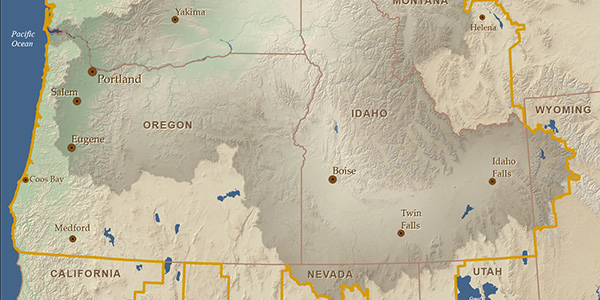By Hudson Sangree
The Bonneville Power Administration signed an implementation agreement with CAISO’s Western Energy Imbalance Market on Thursday, positioning a vast region of the Pacific Northwest, with its powerful hydroelectric dams and thousands of miles of transmission lines, to begin participating in the ISO’s real-time market in 2022.
“We see BPA’s participation in the Western EIM as the natural next step in a collaborative partnership that began many years ago to optimize transmission connections and boost reliability throughout the West,” CAISO CEO Steve Berberich said in a statement. “BPA will provide exceptional benefits to the real-time energy market, as it leverages its robust and regionally strategic transmission system and energy resources.”
BPA would be the largest transmission owner and hydroelectric provider in the EIM. The federal power marketing administration owns and operates three-quarters of the high-voltage transmission lines in the Pacific Northwest, totaling about 15,000 circuit-miles. Its footprint occupies an area larger than the size of France, encompassing the sprawling drainage areas of the Columbia and Snake rivers.
The agency’s assets include 31 hydroelectric projects, such as the 7,079-MW Grand Coulee Dam and the 2,614-MW Chief Joseph Dam. It supplies electricity to 143 electric utilities that serve millions of customers in Washington, Oregon, Idaho, Montana, California, Nevada, Utah and Wyoming.

The Bonneville Power Administration’s service area stretches across a vast area of the Pacific Northwest. | BPA
The move also boosts CAISO’s EIM in competition with WAPA, Basin, Tri-State Sign up with SPP EIS.)
While the implementation agreement is nonbinding, it commits BPA to paying a $1.8 million nonrefundable implementation fee, the first payment of up to $35 million in estimated start-up costs. BPA will not issue its final record of decision on becoming a member until late 2021, just months before it plans to join in March 2022. (See BPA Marches Toward EIM Membership.)
“This milestone was made possible by the collaboration and broad participation of our customers and constituents in the Northwest,” BPA Administrator Elliot Mainzer said in a statement. “We’ve also benefited from a strong partnership with the CAISO that allowed us to carefully explore the value of the EIM for BPA and its customers, while addressing issues important to the region.”
BPA said the EIM will allow it to more efficiently market its hydropower and manage transmission usage and congestion. The agency has touted the ability to use the EIM as a “non-wires” solution to address congestion and avoid new transmission builds while helping to identify areas of needed investment.
“Selling surplus energy and capacity in the Western markets is essential to keeping Bonneville’s rates low,” the agency said on its website. “BPA must adapt its business model as these markets change. Our analysis shows that joining the Western Energy Imbalance Market is one potential method to achieve this outcome.”
In June, BPA kicked off a monthlong public comment process in hopes of signing an implementation agreement with the EIM in September. During a July meeting at BPA headquarters, BPA “preference” customers concerned about their inability to trade in the EIM’s intra-hour market probed agency officials about short-term opportunities to purchase surplus hydropower before it’s offered into the EIM. (See Customers Probe BPA on EIM Impact.) While those concerns remain unresolved, no BPA customers apparently opposed joining the EIM.
“We got 100% support for signing that agreement,” Mainzer said at the Northwest & Intermountain Power Producers Coalition annual meeting in Union, Wash., on Sept. 9.
CAISO is evaluating adding an extended day-ahead market (EDAM) to the real-time EIM to increase its usefulness as a regional marketplace, and the BPA administrator said he believed the EDAM is needed to help move BPA’s hydropower and other renewable resources across the West.
“It’s not going be enough to sell all this stuff on a five-minute market,” Mainzer said.
CAISO says its five-minute market has saved participants more than $736 million in the five years since it started.
The Balancing Area of Northern California (BANC) and the Western Area Power Administration recently said they will sign an implementation agreement with CAISO that would allow WAPA’s Sierra Nevada region and BANC members Modesto Irrigation District, Redding Electric Utility and Roseville Electric Utility to begin trading in the EIM in April 2021. The decision does not affect any other WAPA regions.
WAPA SN would be the first PMA to participate, potentially followed by BPA. The agreement represents the second phase of BANC’s approach to incorporating its members into the EIM. Sacramento Municipal Utility District entered the market in April. (See SMUD Goes Live in Western EIM.)
Other current Western EIM participants include CAISO, PacifiCorp, NV Energy, Arizona Public Service, Puget Sound Energy, Portland General Electric, Idaho Power, Powerex and BANC (Phase 1). The Western EIM is slated to expand with the participation of Salt River Project and Seattle City Light in 2020; Los Angeles Department of Water and Power, NorthWestern Energy, Turlock Irrigation District, Public Service Company of New Mexico and BANC (Phase 2) in 2021; and Tucson Electric Power, Avista and Tacoma Power in 2022.


